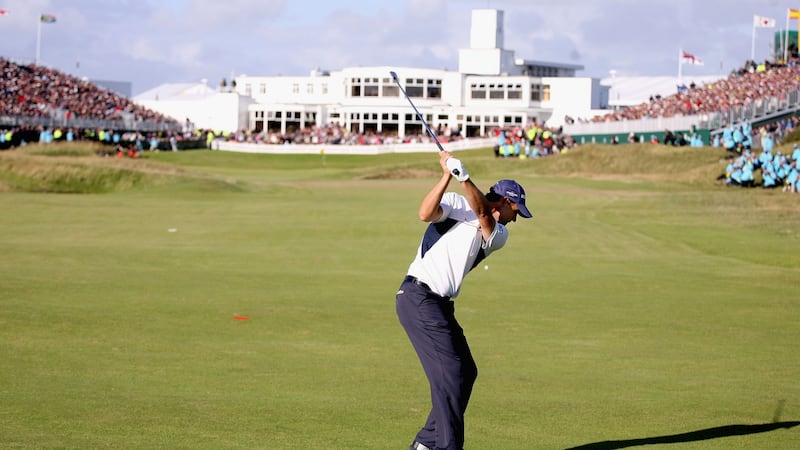Johnny Miller tells a story about playing the last two rounds of the British Open at Royal Birkdale in 1976. The man who would sign his winner's card was a young Spaniard, a virtual unknown at that time, by the name of Seve Ballesteros.
“Nobody really knew who he was, I guess. Maybe in Spain, or maybe a few little European events, but surely nobody in the US did. I was sort of curious watching him. He had this great, big old swing and played super aggressively. I was hitting one-iron off the tee most every hole, and he was playing with his driver.
"He played pretty good on Saturday, but Sunday he was all over the place. I guess the thought of a 19-year-old winning the Open championship was probably, at that point, too much for him because he just started hitting it all over those giant sand dunes," recalled Miller.
Of course we know that Ballesteros went on to become one of the great European players, a global golfing giant, and just three years later would win the first of three Claret Jugs.
But the point of Miller’s story is not so much about the swashbuckling Spaniard, but of what can happen at Birkdale when there is no accuracy off the tee; for, of all the championship courses on the British Open rota, this is one that can devour errant players.

How tough can it be? In each of the last two British Opens at Birkdale, the Par 4 sixth hole has proven to be the toughest of all. In 1998, it played to an average of 4.61; and, in 2008, it played to an average of 4.76; that year, there were only 10 birdies recorded, along with 160 pars, 246 bogeys, 53 double bogeys and seven triples or worse.
Yet, it is also seen as one of the fairest examinations on the rota. What you see is what you get. Or, as Graeme McDowell once described it: “It’s got the real classic links feel to it. It’s not tricked up; it’s just a solid, tough test, fair. You hit good shots, you get rewarded. The place is not tricked up in any way, shape or form.”
This is the 10th time the Open will be played at Royal Birkdale, where the wind coming off the Irish Sea – as on every links – offers the primary defence. When Pádraig Harrington successfully defended his title in 2008, winds at times reached 30 miles per hour. Trevor Immelman described it as "the toughest" course he had ever played. And Harrington's winning score, three-over-par 283, was the highest winning total of any Open played on the Lancashire links.
Practice rounds
In an ironic twist, Harrington – who had injured his right wrist when hitting his driver into a bean bag in a training exercise – was one of the freshest players come the actual championship because he’d been unable to play any full practice rounds.
In fact, up until the Wednesday night, Harrington had wondered if he'd be able to play. It was then that Dr Bob Rotella, his sports psychologist, told him: "Look, pain is there but you can play through that."
When it was all over, Harrington confessed: “The injury took all the pressure and stress and expectation away from my game.”

What it also meant was that Harrington, who emerged on top of the pile that week, was strategic and straight off the tee. For instance, in his play of the 17th which became the iconic memory, Harrington hit five-wood off the tee and, then, with 249 yards to the flag, hit a five-wood approach to three feet for eagle.
What Harrington did for the most part in 2008 was to keep his tee shots on the short grass. As Miller did in 1976. As Mark O’Meara did in 1998.
I believe that golf was meant to be played links style, that's the way it was designed to be played, that's the way it all started
“The big thing about Birkdale is that it’s surrounded by those dunes and long grass. It’s actually pretty hard to scramble if you hit it wildly, unlike Troon or some of those other courses where you can hit it out in the car park. Birkdale, if you hit it wildly, it’s pretty penal. It doesn’t seem to have the Scottish cachet as much as a St Andrews or a Carnoustie or Muirfield or whatever. But hole-for-hole, it doesn’t have to take a back seat to any of the rotation,” said Miller of the links.
For O’Meara, that British Open win cemented a love affair with links golf.
“I believe that golf was meant to be played links style, that’s the way it was designed to be played, that’s the way it all started. The creativity factor and the elements, those are all things that make it even more special. One minute you can be playing in benign conditions and the next very difficult conditions.
“But I always liked the creativity part of it, where you had to create shots. You might hit a six iron 92 yards one hole and then next you’re hitting an eight iron 210 yards. There’s really nowhere else in the world you can do that.”
Tough, but fair. That’s Royal Birkdale.
Past Champions at Royal Birkdale
1954: Peter Thomson (Australia) 283 (-9)
1961: Arnold Palmer (USA) 284 (-4)
1965: Thomson 285 (-7)
1971: Lee Trevino (USA) 278 (-4)
1976: Johnny Miller (USA) 279 (-9)
1983: Tom Watson (USA) 275 (-9)
1991: Ian Baker Finch (Australia) 272 (-8)
1998: Mark O'Meara (USA) 280 (E)
2008: Pádraig Harrington (Ireland) 283 (+3)
*Par 73 (1954, 1965, 1971)
**Par 72 (1961,1976)
***Par 71 (1983)
****Par 70 (1991, 1998, 2008)
CHAMPION BENEFITS
The winner of the Open receives:
MONEY
€1,617,215 ($1,845,000)
TROPHY
The Golf Champion Trophy, now commonly referred to as the Claret Jug, was made by Mackay Cunningham & Company of Edinburgh and was hallmarked 1873. The first Open Champion to receive the new trophy was the 1873 winner, Tom Kidd, but Tom Morris Junior's name was the first to be engraved on it as the 1872 winner.
MEDAL
The first time a medal was given to the winner was in 1872, when no trophy was available. Unlike the Claret Jug, which must be returned in time for the next Championship, the Gold Medal is kept by the winner. The early Gold Medals, which in fact were silver gilt, were large ovals with a central design of a shield and crossed clubs. Around the edge was the inscription ‘Golf Champion Trophy’. During the late 1880s and early 1890s, the design of the medal underwent several changes. The circular medal was first introduced in 1893 and the basic size and shape has not changed since then.
















